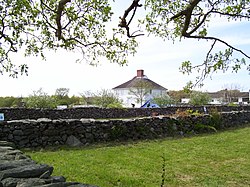
Rhode Island, officially the State of Rhode Island, is a state in the New England region of the Northeastern United States. It is the smallest U.S. state by area and the seventh-least populous, with slightly fewer than 1.1 million residents as of 2020, but it is the second-most densely populated after New Jersey. It takes its name from the eponymous island, though most of its land area is on the mainland. Rhode Island borders Connecticut to the west, Massachusetts to the north and east, and the Atlantic Ocean to the south via Rhode Island Sound and Block Island Sound; it also shares a small maritime border with New York. Providence is its capital and most populous city.

Newport is a seaside city on Aquidneck Island in Newport County, Rhode Island. It is located in Narragansett Bay, approximately 33 miles (53 km) southeast of Providence, 20 miles (32 km) south of Fall River, Massachusetts, 74 miles (119 km) south of Boston, and 180 miles (290 km) northeast of New York City. It is known as a New England summer resort and is famous for its historic mansions and its rich sailing history. It was the location of the first U.S. Open tournaments in both tennis and golf, as well as every challenge to the America's Cup between 1930 and 1983. It is also the home of Salve Regina University and Naval Station Newport, which houses the United States Naval War College, the Naval Undersea Warfare Center, and an important Navy training center. It was a major 18th-century port city and boasts many buildings from the Colonial era.

The Breakers is a Gilded Age mansion located at 44 Ochre Point Avenue, Newport, Rhode Island, US. It was built between 1893 and 1895 as a summer residence for Cornelius Vanderbilt II, a member of the wealthy Vanderbilt family. The 70-room mansion, with a gross area of 125,339 square feet (11,644.4 m2) and 62,482 square feet (5,804.8 m2) of living area on five floors, was designed by Richard Morris Hunt in the Renaissance Revival style; the interior decor was by Jules Allard and Sons and Ogden Codman Jr. The Ochre Point Avenue entrance is marked by sculpted iron gates, and the 30-foot-high (9.1 m) walkway gates are part of a 12-foot-high (3.7 m) limestone-and-iron fence that borders the property on all but the ocean side. The footprint of the house covers approximately 1 acre (4,000 m2) or 43,000 square feet of the 14 acres (5.7 ha) estate on the cliffs overlooking Easton Bay of the Atlantic Ocean.
The Narragansett Council of the Boy Scouts of America serves all of the state of Rhode Island and some of Massachusetts and Connecticut. Its several camps include Camp Yawgoog and Camp Cachalot.

The Touro Synagogue or Congregation Jeshuat Israel is a synagogue built in 1763 in Newport, Rhode Island. It is the oldest synagogue building still standing in the United States, the only surviving synagogue building in the U.S. dating to the colonial era, and the oldest surviving Jewish synagogue building in North America. In 1946, it was declared a National Historic Site.

Scouting in Rhode Island has a long history, from the 1910s to the present day, serving thousands of youth in programs that suit the environment in which they live.

Thomas Lincoln Casey Sr. was a noted American military and civil engineer of the late 19th century. He served as Chief of Engineers for the United States Army Corps of Engineers and oversaw the completion of the Washington Monument. American engineer Richard Weingardt wrote that Casey was the "U.S. Army Corps of Engineers’ most visible and celebrated builder of public buildings, monuments, and other significant works in the latter part of the 19th century."

John Coggeshall Sr. was one of the founders of the Colony of Rhode Island and Providence Plantations and the first President of all four towns in the Colony. He was a successful silk merchant in Essex, England, but he emigrated to the Massachusetts Bay Colony in 1632 and quickly assumed a number of roles in the colonial government. In the mid-1630s, he became a supporter of dissident minister John Wheelwright and of Anne Hutchinson. Hutchinson was tried as a heretic in 1637, and Coggeshall was one of three deputies who voted for her acquittal. She was banished from the colony in 1638, and the three deputies who voted for her acquittal were also compelled to leave. Before leaving Boston, Coggeshall and many other Hutchinson supporters signed the Portsmouth Compact in March 1638 agreeing to form a government based on the individual consent of the inhabitants. They then established the settlement of Portsmouth on Aquidneck Island, one of the four towns comprising the Colony of Rhode Island and Providence Plantations.

Saunderstown is a small village and historic district in the towns of Narragansett and North Kingstown in Washington County, Rhode Island, United States. Saunderstown has its own post office with the ZIP Code of 02874, which also includes a small part of South Kingstown. Its population is 6,245.

Thomas Alexander Tefft was an American architect, from Providence, Rhode Island. Tefft, one of the nation's first professionally trained architects, is considered a master of Rundbogenstil and a leading American proponent of its use. Prior to his untimely death, Tefft "offered the most advanced designs of [his] day in America"

The stone-ender is a unique style of Rhode Island architecture that developed in the 17th century where one wall in a house is made up of a large stone chimney.
Nicholas Easton (c.1593–1675) was an early colonial President and Governor of Rhode Island. Born in Hampshire, England, he lived in the towns of Lymington and Romsey before immigrating to New England with his two sons in 1634. Once in the New World, he lived in the Massachusetts Bay Colony towns of Ipswich, Newbury, and Hampton. Easton supported the dissident ministers John Wheelwright and Anne Hutchinson during the Antinomian Controversy, and was disarmed in 1637, and then banished from the Massachusetts colony the following year. Along with many other Hutchinson supporters, he settled in Portsmouth on Aquidneck Island, later a part of the Colony of Rhode Island and Providence Plantations. He was in Portsmouth for about a year when he and eight others signed an agreement to create a plantation elsewhere on the island, establishing the town of Newport.
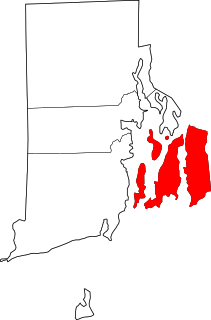
This is a list of the National Register of Historic Places listings in Newport County, Rhode Island.
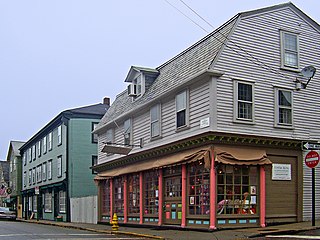
The Newport Historic District is a historic district that covers 250 acres in the center of Newport in the U.S. state of Rhode Island. It was designated a National Historic Landmark (NHL) in 1968 due to its extensive and well-preserved assortment of intact colonial buildings dating from the early and mid-18th century. Six of those buildings are themselves NHLs in their own right, including the city's oldest house and the former meeting place of the colonial and state legislatures. Newer and modern buildings coexist with the historic structures.
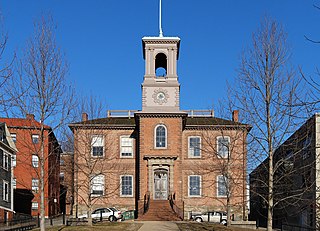
The Old State House on College Hill in Providence, Rhode Island, also known as Providence Sixth District Court House,Providence Colony House, Providence County House, and Rhode Island State House is located on 150 Benefit Street, with the front facade facing North Main Street. It is a brick Georgian-style building largely completed in 1762. It was used as the meeting place for the colonial and state legislatures for 149 years.
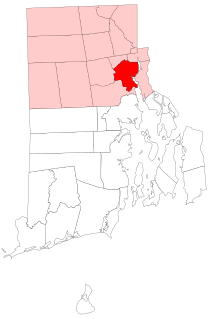
This is a list of the National Register of Historic Places listings in Providence, Rhode Island.

The state of Rhode Island during the American Civil War remained loyal to the Union, as did the other states of New England. Rhode Island furnished 25,236 fighting men to the Union Army, of which 1,685 died. The state used its industrial capacity to supply the Union Army with the materials needed to win the war. Rhode Island's continued growth and modernization led to the creation of an urban mass transit system and improved health and sanitation programs.
John Coggeshall Jr. was a deputy governor of the Colony of Rhode Island and Providence Plantations. The son of Rhode Island President John Coggeshall Sr., he was raised in the village of Castle Hedingham in northeastern Essex where his father was a merchant. Aged about eight, he sailed from England with his parents and surviving siblings, arriving in New England in 1632. He was first active in civil affairs in 1653 when he became treasurer of the island towns of Portsmouth and Newport. The following year brought the re-unification of the colony, with the island towns rejoining the government with Providence and Warwick, and he served as treasurer of the four towns for a year. His name appears on a list of Newport freemen in 1655, and for the following 35 years he served almost continuously in one or multiple roles including Assistant, General Treasurer, Deputy, General Recorder, and Major for the Island. He was one of ten Assistants named in the Royal Charter of 1663, which would become the basis for Rhode Island's government for nearly two centuries. In 1686 he became the Deputy Governor under Governor Walter Clarke, but his term lasted only a month when the English crown assigned Edmund Andros to be Governor of all the New England colonies under the Dominion of New England. Following the demise of this dominion and the arrest of Andros in 1689, Coggeshall was once again selected as Deputy Governor for the year ending in May 1690, serving under Governor Henry Bull. In April 1676, during King Philip's War, he was on a committee to procure boats for the colony's defense. Later that year, in August, he was a member of a court martial for the trial of several Indians.

Alpheus C. Morse (1818-1893) was an American architect with offices in Providence, Rhode Island.

Antoinette Forrester Downing was an architectural historian and preservationist who authored the standard reference work on historical houses in Rhode Island. She is credited with spearheading a movement that saved many of Providence's historic buildings from demolition in the mid 20th century and for her leadership was inducted into the Rhode Island Heritage Hall of Fame in 1978.
